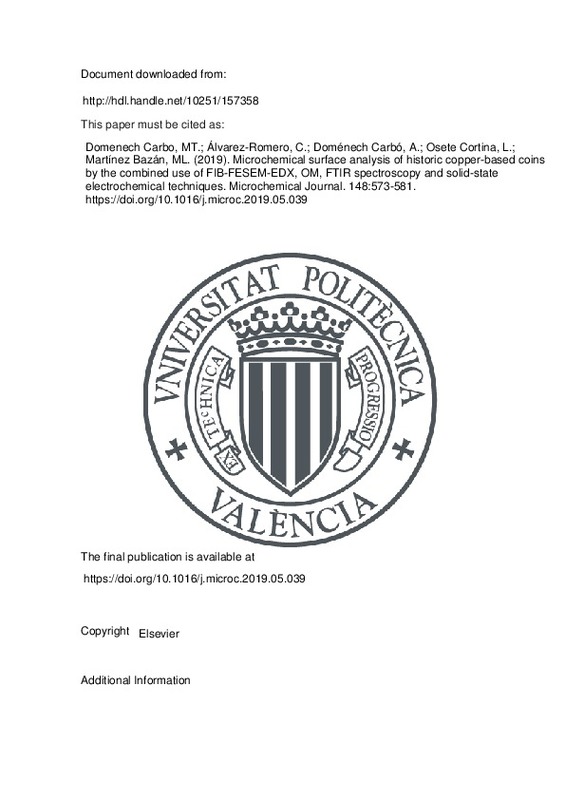JavaScript is disabled for your browser. Some features of this site may not work without it.
Buscar en RiuNet
Listar
Mi cuenta
Estadísticas
Ayuda RiuNet
Admin. UPV
Microchemical surface analysis of historic copper-based coins by the combined use of FIB-FESEM-EDX, OM, FTIR spectroscopy and solid-state electrochemical techniques
Mostrar el registro sencillo del ítem
Ficheros en el ítem
| dc.contributor.author | Domenech Carbo, Mª Teresa
|
es_ES |
| dc.contributor.author | Álvarez-Romero, Carla
|
es_ES |
| dc.contributor.author | DOMÉNECH CARBÓ, ANTONIO
|
es_ES |
| dc.contributor.author | Osete Cortina, Laura
|
es_ES |
| dc.contributor.author | Martínez Bazán, Mª Luisa
|
es_ES |
| dc.date.accessioned | 2020-12-18T04:31:37Z | |
| dc.date.available | 2020-12-18T04:31:37Z | |
| dc.date.issued | 2019-07 | es_ES |
| dc.identifier.issn | 0026-265X | es_ES |
| dc.identifier.uri | http://hdl.handle.net/10251/157358 | |
| dc.description.abstract | [EN] A multi-technique strategy, including microscopy, spectroscopic and electrochemical techniques, is proposed to study thin corrosion layers that form on the surface of historic copper-based coins. An accurate characterisation of this external corrosion layer is important for selecting a suitable conservation and/or restoration treatment. For this purpose, a series of copper-based coins from different historical periods and provenances, which mainly exhibited atmospheric corrosion, was analysed. The morphology of the corrosion layer and the upper core of coins was studied in trenches done on coin surfaces with a focused ion beam gun, coupled to a field emission scanning electron microscope-X-ray microanalysis (FIB-FESEM-EDX). The X-ray microanalysis performed with FESEM-EDX on trenches allowed elemental composition profiles on the corrosion layer to be obtained. These results were complemented with the compositional data of the corrosion products provided by the voltammetry of immobilised microparticles (VIMP) and Fourier transform infrared spectroscopy (FTIR), and by studying visual appearance by optical microscopy and colorimetry. Cuprite and tenorite (the latter increased with coin age) were the main identified corrosion products, which were accompanied, to a lesser extent, by copper trihydroxychloride polymorphs. Interestingly, metal oxalates and metal-carboxylate complexes were identified on the corrosion layer of most coins. These unusual alteration products of copper-based coins were formed from the organic matter deposited on coin surfaces given their use when placed in circulation or by further manipulations of collectors. | es_ES |
| dc.description.sponsorship | Financial support is gratefully acknowledged from the Spanish "R + D + I" project CTQ2017-85317-C2-1-P, CTQ2014-53736-C3-1-P and CTQ2014-53736-C3-2-P, which are supported by the Ministerio de Ciencia, Innovation y Universidades, Fondo Europeo de Desarrollo Regional (ERDF) funds and Agencia Estatal de Investigation (AEI). The authors wish to thank Mr. Manuel Planes, Dr. Jose Luis Moya and Mrs. Alicia Nuez Inbernon, technical supervisors of the Electron Microscopy Service of the Universitat Politecnica de Valencia. | es_ES |
| dc.language | Inglés | es_ES |
| dc.publisher | Elsevier | es_ES |
| dc.relation.ispartof | Microchemical Journal | es_ES |
| dc.rights | Reconocimiento - No comercial - Sin obra derivada (by-nc-nd) | es_ES |
| dc.subject | FIB-FESEM-EDX | es_ES |
| dc.subject | FTIR spectroscopy | es_ES |
| dc.subject | Voltammetry of microparticles | es_ES |
| dc.subject | Corrosion products | es_ES |
| dc.subject | Coin | es_ES |
| dc.subject | Heritage conservation | es_ES |
| dc.subject.classification | PINTURA | es_ES |
| dc.title | Microchemical surface analysis of historic copper-based coins by the combined use of FIB-FESEM-EDX, OM, FTIR spectroscopy and solid-state electrochemical techniques | es_ES |
| dc.type | Artículo | es_ES |
| dc.identifier.doi | 10.1016/j.microc.2019.05.039 | es_ES |
| dc.relation.projectID | info:eu-repo/grantAgreement/MINECO//CTQ2014-53736-C3-1-P/ES/APLICACION DE LAS TECNICAS NANOELECTROQUIMICAS Y BIOTECNOLOGIAS EN EL ESTUDIO Y CONSERVACION DEL PATRIMONIO EN METAL/ | es_ES |
| dc.relation.projectID | info:eu-repo/grantAgreement/MINECO//CTQ2014-53736-C3-2-P/ES/APLICACION DE LAS TECNICAS NANOELECTROQUIMICAS Y BIOTECNOLOGICAS EN EL ESTUDIO Y CONSERVACION DEL PATRIMONIO EN METAL/ | es_ES |
| dc.relation.projectID | info:eu-repo/grantAgreement/AEI/Plan Estatal de Investigación Científica y Técnica y de Innovación 2013-2016/CTQ2017-85317-C2-1-P/ES/APLICACION DE TECNICAS AVANZADAS DE MICROSCOPIA EN EL ESTUDIO DEL PATRIMONIO CERAMICO Y VITREO/ | es_ES |
| dc.rights.accessRights | Abierto | es_ES |
| dc.contributor.affiliation | Universitat Politècnica de València. Departamento de Conservación y Restauración de Bienes Culturales - Departament de Conservació i Restauració de Béns Culturals | es_ES |
| dc.description.bibliographicCitation | Domenech Carbo, MT.; Álvarez-Romero, C.; Doménech Carbó, A.; Osete Cortina, L.; Martínez Bazán, ML. (2019). Microchemical surface analysis of historic copper-based coins by the combined use of FIB-FESEM-EDX, OM, FTIR spectroscopy and solid-state electrochemical techniques. Microchemical Journal. 148:573-581. https://doi.org/10.1016/j.microc.2019.05.039 | es_ES |
| dc.description.accrualMethod | S | es_ES |
| dc.relation.publisherversion | https://doi.org/10.1016/j.microc.2019.05.039 | es_ES |
| dc.description.upvformatpinicio | 573 | es_ES |
| dc.description.upvformatpfin | 581 | es_ES |
| dc.type.version | info:eu-repo/semantics/publishedVersion | es_ES |
| dc.description.volume | 148 | es_ES |
| dc.relation.pasarela | S\389193 | es_ES |
| dc.contributor.funder | Agencia Estatal de Investigación | es_ES |
| dc.contributor.funder | European Regional Development Fund | es_ES |
| dc.contributor.funder | Ministerio de Economía y Competitividad | es_ES |







![[Cerrado]](/themes/UPV/images/candado.png)

